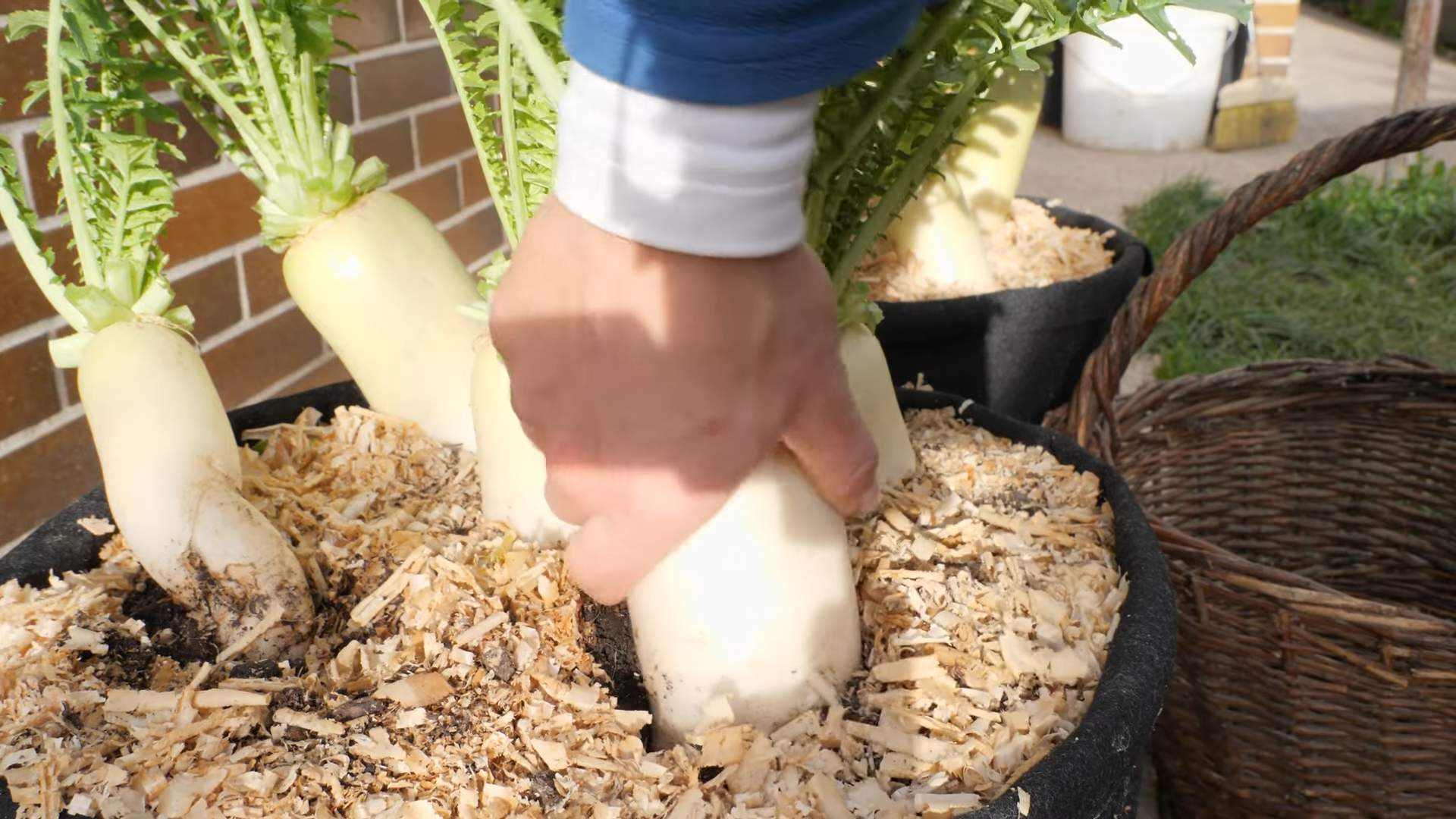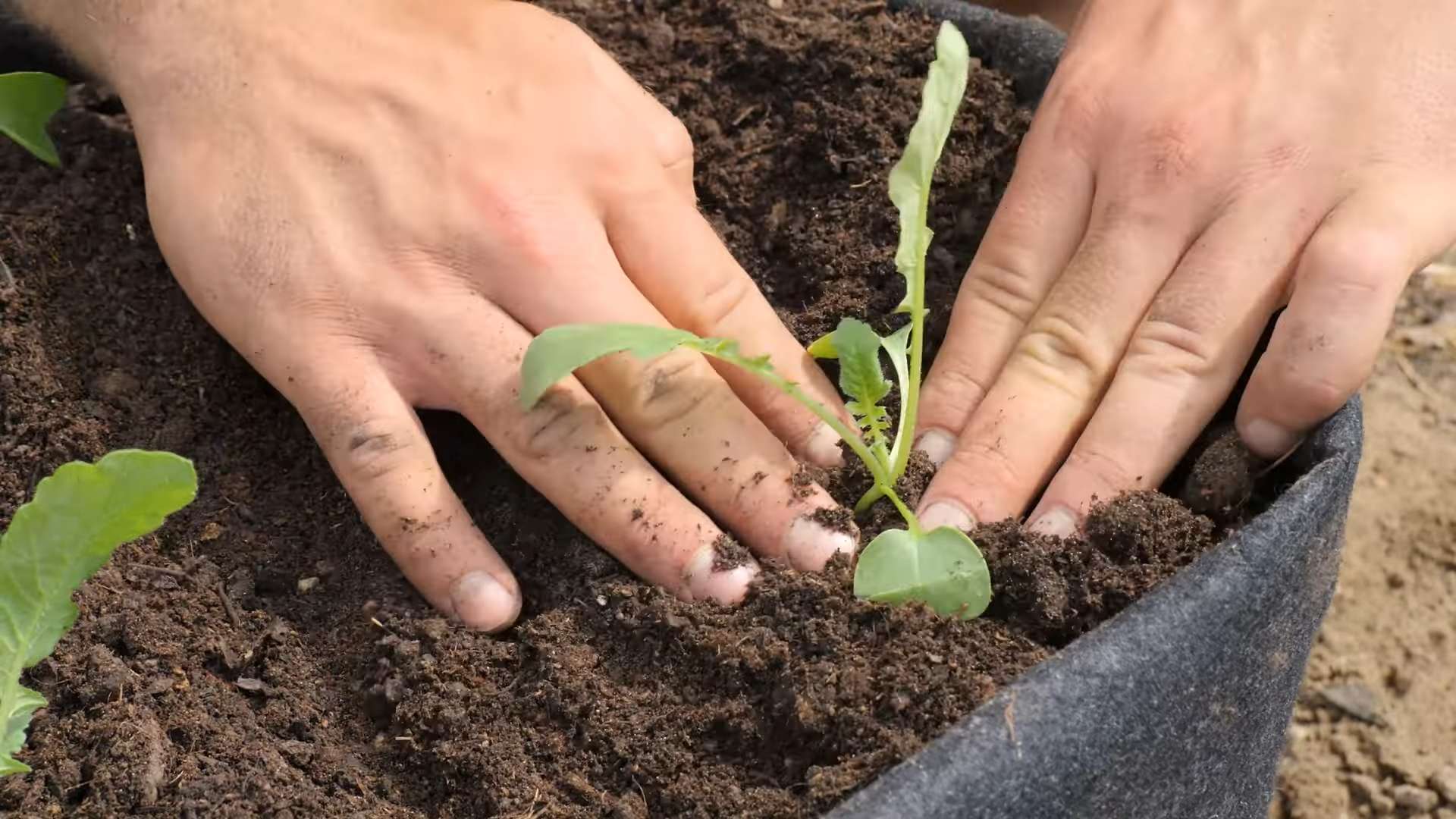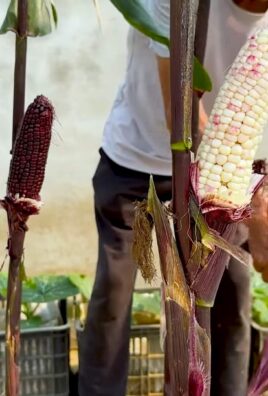Grow Radishes Indoors Kitchen: Imagine plucking crisp, peppery radishes straight from your kitchen counter, even in the dead of winter! Sounds like a dream, right? Well, it doesn’t have to be! For centuries, humans have cultivated food in various ways, adapting to climates and spaces. From ancient rooftop gardens in Babylon to modern-day vertical farms, the desire to nurture life and enjoy fresh produce has always been a part of our story.
But let’s be honest, not everyone has a sprawling backyard or the time for extensive gardening. That’s where the magic of indoor gardening comes in! And that’s why I’m so excited to share these simple, effective DIY tricks to help you grow radishes indoors kitchen.
This isn’t just about having a cute little plant on your windowsill; it’s about accessing fresh, healthy food, reducing your carbon footprint, and connecting with nature, all from the comfort of your home. Plus, radishes are incredibly fast-growing, making them perfect for impatient gardeners (like me!). So, ditch the store-bought veggies and let’s get our hands dirty (or, well, maybe just a little bit damp!) with these easy-to-follow tips and hacks. You’ll be amazed at how rewarding it is to cultivate your own little radish patch right in your kitchen!

Growing Radishes Indoors: A Kitchen Garden Delight
Hey there, fellow gardening enthusiasts! Ever thought about having fresh, peppery radishes right at your fingertips, even when the weather outside is frightful? Well, you can! Growing radishes indoors is surprisingly easy and rewarding. I’m going to walk you through everything you need to know to cultivate these crunchy delights in your very heart of your kitchen.
What You’ll Need
Before we dive into the nitty-gritty, let’s gather our supplies. Here’s a checklist of everything you’ll need to get started:
* **Radish Seeds:** Opt for varieties specifically bred for quick growth and smaller spaces. ‘Cherry Belle,’ ‘French Breakfast,’ and ‘Easter Egg’ are excellent choices. I personally love ‘Cherry Belle’ for their vibrant color and mild flavor.
* **Containers:** You’ll need containers that are at least 6 inches deep. Radishes need room to grow downwards. I recommend using plastic pots, terracotta pots, or even repurposed containers like yogurt tubs (just make sure they have drainage holes!).
* **Potting Mix:** Use a well-draining potting mix. Avoid using garden soil, as it can compact and hinder root growth. A mix of peat moss, perlite, and vermiculite works wonders. I usually buy a pre-mixed potting mix to save time and effort.
* **Grow Lights (Optional but Recommended):** While radishes can grow indoors with natural light, they thrive under grow lights. This is especially important if you don’t have a south-facing window that receives at least 6 hours of direct sunlight. I use LED grow lights because they’re energy-efficient and don’t produce excessive heat.
* **Watering Can or Spray Bottle:** For gentle watering.
* **Small Trowel or Spoon:** For planting seeds.
* **Fertilizer (Optional):** A balanced liquid fertilizer can give your radishes a boost, but it’s not strictly necessary. I use a diluted solution of fish emulsion every few weeks.
Choosing the Right Radish Variety
Not all radishes are created equal, especially when it comes to indoor growing. You’ll want to select varieties that are known for their quick maturity and compact size. Here are a few of my favorites:
* **Cherry Belle:** As I mentioned earlier, this is a classic choice. They mature quickly (around 22 days) and have a mild, slightly sweet flavor.
* **French Breakfast:** These radishes are elongated with a red top and white bottom. They have a slightly spicier flavor than Cherry Belle and mature in about 25 days.
* **Easter Egg:** This variety produces a mix of red, pink, purple, and white radishes, adding a splash of color to your indoor garden. They mature in about 28 days.
* **Sparkler:** Another quick-growing variety, Sparkler radishes are round and red with a white tip. They have a crisp texture and a mild flavor.
Planting Your Radish Seeds
Alright, let’s get our hands dirty! Here’s how to plant your radish seeds:
1. **Prepare Your Containers:** Fill your containers with potting mix, leaving about an inch of space at the top. Gently pat down the soil to create a level surface.
2. **Sow the Seeds:** Sow the radish seeds about ½ inch deep and 1 inch apart. You can use your finger or a small trowel to create small holes for the seeds. I usually plant a few extra seeds in each container to ensure good germination.
3. **Cover the Seeds:** Gently cover the seeds with potting mix and lightly water the soil.
4. **Label Your Containers:** Don’t forget to label your containers with the radish variety and the date you planted them. This will help you keep track of your progress.
5. **Provide Light:** Place your containers in a sunny location or under grow lights. If using grow lights, position them a few inches above the soil surface.
Caring for Your Indoor Radishes
Now that your radishes are planted, it’s time to provide them with the care they need to thrive.
1. **Watering:** Keep the soil consistently moist, but not waterlogged. Water when the top inch of soil feels dry to the touch. I prefer to use a spray bottle to gently water the seedlings, avoiding overwatering.
2. **Thinning:** Once the seedlings emerge (usually within a few days), thin them out so that they are about 1 inch apart. This will give them enough space to grow properly. I know it’s hard to pull out those tiny seedlings, but it’s essential for healthy radish growth.
3. **Fertilizing (Optional):** If you choose to fertilize, use a balanced liquid fertilizer diluted to half strength. Apply the fertilizer every few weeks, following the instructions on the product label.
4. **Light:** Radishes need at least 6 hours of direct sunlight per day. If you don’t have enough natural light, use grow lights to supplement.
5. **Temperature:** Radishes prefer cool temperatures, ideally between 60°F and 70°F (15°C and 21°C). Avoid placing them near heat sources, such as radiators or ovens.
6. **Air Circulation:** Good air circulation is important to prevent fungal diseases. Make sure your radishes have enough space around them and avoid overcrowding.
Harvesting Your Radishes
The best part of growing radishes is, of course, harvesting them! Radishes are typically ready to harvest in 3-4 weeks, depending on the variety.
1. **Check for Maturity:** Gently brush away the soil around the base of the radish to check its size. Radishes are usually ready to harvest when they are about 1 inch in diameter.
2. **Harvest Carefully:** Gently pull the radishes out of the soil, being careful not to damage the roots. If the soil is dry, you may need to loosen it with a trowel before pulling.
3. **Wash and Enjoy:** Wash the radishes thoroughly and enjoy them fresh. You can eat them raw in salads, sandwiches, or as a snack. You can also cook them in stir-fries or soups. I love slicing them thinly and adding them to a simple salad with a vinaigrette dressing.
Troubleshooting Common Problems
Even with the best care, you may encounter some problems when growing radishes indoors. Here are a few common issues and how to address them:
* **Leggy Seedlings:** This is usually caused by insufficient light. Make sure your radishes are getting enough sunlight or grow light.
* **Slow Growth:** This can be caused by several factors, including poor soil, insufficient water, or lack of nutrients. Make sure you are using a well-draining potting mix, watering regularly, and fertilizing if necessary.
* **Cracked Radishes:** This is usually caused by inconsistent watering. Make sure you are watering regularly and avoiding letting the soil dry out completely.
* **Pests:** Radishes are relatively pest-resistant, but they can sometimes be affected by aphids or flea beetles. If you notice pests, you can try spraying them with insecticidal soap or neem oil.
Extending Your Harvest
To enjoy a continuous supply of radishes, you can practice succession planting. This involves planting a new batch of seeds every week or two. This way, you’ll always have radishes ready to harvest. I usually stagger my plantings so that I have a fresh batch of radishes every few weeks.
Creative Uses for Your Radishes
Beyond the classic salad, there are tons of ways to enjoy your homegrown radishes. Here are a few ideas to get you started:
* **Radish Greens:** Don’t throw away the radish greens! They are edible and nutritious. You can add them to salads, stir-fries, or soups. I love sautéing them with garlic and olive oil.
* **Radish Butter:** Mix grated radishes with softened butter and herbs for a flavorful spread.
* **Pickled Radishes:** Preserve your radishes by pickling them in vinegar, sugar, and spices.
* **Radish Salsa:** Combine diced radishes with tomatoes, onions, cilantro, and lime juice for a refreshing salsa.
* **Roasted Radishes:** Roasting radishes brings out their sweetness and mellows their flavor.
Final Thoughts
Growing radishes indoors is a fun and rewarding experience. With a little bit of care and attention, you can enjoy fresh, peppery radishes all year round. So, grab some seeds, get your hands dirty, and start growing your own indoor radish garden today! I promise, you won’t regret it. Happy gardening!

Conclusion
So, there you have it! Growing radishes indoors in your kitchen is not only possible, but it’s surprisingly simple and incredibly rewarding. Forget those bland, store-bought radishes that lack that peppery zing. With this DIY trick, you can enjoy fresh, crisp, and flavorful radishes right from your own countertop, any time of year.
Why is this a must-try? Because it puts you in control of your food source. You know exactly what goes into your radishes – no pesticides, no questionable fertilizers, just good old-fashioned soil, water, and light. Plus, it’s a fantastic way to introduce children to the wonders of gardening and where their food comes from. Imagine the excitement of watching those tiny seeds sprout and transform into vibrant, edible roots!
Beyond the basic method, there’s plenty of room for experimentation. Try different varieties of radishes to discover your favorites. ‘Cherry Belle’ is a classic for its quick growth and mild flavor, while ‘French Breakfast’ offers a more elongated shape and a slightly spicier bite. You can even explore heirloom varieties for unique colors and flavors.
Consider using different types of containers. While a standard pot works perfectly well, you could also repurpose old yogurt containers, plastic tubs, or even create a vertical garden using stacked planters. Just ensure that your chosen container has adequate drainage.
Another variation to consider is companion planting. Radishes are known to be good companions for carrots, lettuce, and spinach. Planting them together can help deter pests and improve the overall health of your indoor garden.
Don’t be afraid to experiment with different lighting conditions. While a sunny windowsill is ideal, you can also supplement with grow lights, especially during the darker winter months. This will ensure that your radishes receive the light they need to thrive.
The beauty of this DIY trick is its accessibility. You don’t need a green thumb or a lot of space to succeed. All you need is a little bit of patience and a willingness to learn. And the payoff – fresh, delicious radishes at your fingertips – is well worth the effort.
We wholeheartedly encourage you to give this DIY trick a try. It’s a fun, educational, and ultimately delicious way to bring a little bit of the garden indoors. And once you’ve harvested your first batch of homegrown radishes, we’d love to hear about your experience! Share your photos, tips, and tricks in the comments below. Let’s create a community of indoor radish growers and inspire others to embrace the joy of homegrown food. Remember, growing radishes indoors is more than just a gardening project; it’s a step towards a more sustainable and flavorful lifestyle. So, grab your seeds, soil, and containers, and get ready to enjoy the taste of homegrown goodness!
Frequently Asked Questions (FAQ)
What kind of soil should I use for growing radishes indoors?
The best soil for growing radishes indoors is a well-draining potting mix. Avoid using garden soil, as it can be too heavy and compact, which can hinder root development. Look for a potting mix that contains ingredients like peat moss, perlite, and vermiculite, which will provide good drainage and aeration. You can also amend your potting mix with compost to add nutrients and improve its water-holding capacity. A slightly acidic to neutral pH (around 6.0 to 7.0) is ideal for radishes.
How much light do radishes need when grown indoors?
Radishes need at least 6 hours of direct sunlight per day to thrive. A sunny windowsill facing south or west is usually sufficient. However, if you don’t have access to a sunny window, or if you live in an area with limited sunlight, you can supplement with grow lights. Fluorescent or LED grow lights are a good option. Position the lights a few inches above the plants and keep them on for 12-14 hours per day. Insufficient light can result in leggy plants with small, underdeveloped roots.
How often should I water my indoor radishes?
Radishes need consistent moisture to grow properly, but they don’t like to be waterlogged. Water your radishes when the top inch of soil feels dry to the touch. Water thoroughly, until water drains out of the bottom of the container. Avoid overwatering, as this can lead to root rot. Check the soil moisture regularly and adjust your watering schedule as needed, depending on the temperature and humidity in your home.
How long does it take for radishes to grow indoors?
One of the great things about radishes is that they are quick to mature. Most varieties of radishes will be ready to harvest in 3-4 weeks from planting. The exact time will depend on the variety, the growing conditions, and the amount of light they receive. Check the seed packet for specific information on the maturity time of the variety you are growing.
How do I know when my radishes are ready to harvest?
You can tell when radishes are ready to harvest by their size. Most varieties are ready to harvest when they are about 1 inch in diameter. Gently brush away some of the soil around the base of the plant to check the size of the root. You can also harvest a few radishes early to get an idea of their flavor and texture. If they are too small, leave the remaining radishes to grow for a few more days.
What are some common problems when growing radishes indoors and how can I fix them?
Some common problems when growing radishes indoors include:
* **Leggy plants:** This is usually caused by insufficient light. Provide more light, either by moving the plants to a sunnier location or by using grow lights.
* **Small roots:** This can be caused by several factors, including insufficient light, overcrowding, or poor soil. Make sure your radishes are getting enough light, thin them out if they are too crowded, and use a well-draining potting mix.
* **Root rot:** This is caused by overwatering. Allow the soil to dry out slightly between waterings and make sure your container has good drainage.
* **Pests:** Aphids and flea beetles can sometimes be a problem. Inspect your plants regularly and treat any infestations with insecticidal soap or neem oil.
Can I grow radishes in a container without drainage holes?
While it’s possible to grow radishes in a container without drainage holes, it’s generally not recommended. Without drainage, the soil can easily become waterlogged, which can lead to root rot and other problems. If you do choose to use a container without drainage holes, be extra careful not to overwater. Add a layer of gravel or pebbles to the bottom of the container to improve drainage and monitor the soil moisture closely.
Can I eat the radish greens?
Yes, radish greens are perfectly edible and nutritious! They have a peppery flavor similar to the roots. You can use them in salads, soups, stir-fries, or as a garnish. Make sure to wash them thoroughly before eating.
How do I store harvested radishes?
To store harvested radishes, remove the greens and store them separately. Place the radishes in a plastic bag or container in the refrigerator. They will keep for several weeks. The greens should be used within a few days.
Can I regrow radishes from the tops?
While you can’t regrow a whole radish from the top, you can potentially grow radish seed pods if you leave the tops attached to a small portion of the root and replant them. The plant will then flower and produce seed pods. However, this process takes much longer than growing radishes from seed.




Leave a Comment